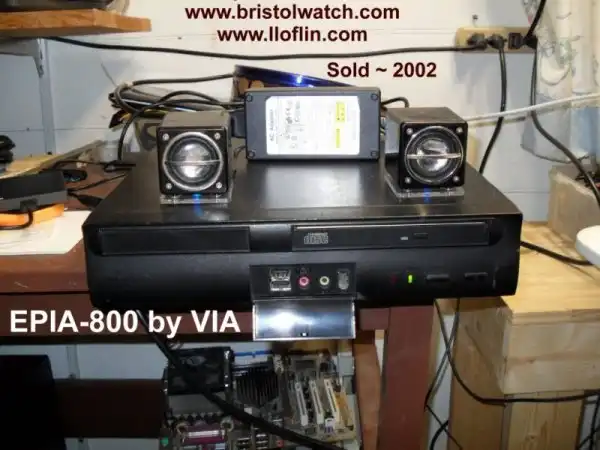
Fig. 1
Live Test 2002 VIA EPIA-800 Mini ITX Motherboard
The EPIA-800 is one of the first low-power mini-ITX motherboards. Introduced in 2002 it pushed available technology to the limit.
Available from Ebay where I bought mine a few years ago, a used motherboard averaged about $40. An unused EPIA-800 motherboard was offered for $500. That is insane in my opinion.
As of June 6, 2021 there are 7 listings on Ebay ranging from over $50 to $750. Only one offer had 256Meg RAM, none offered the back I/O plate or memory.
I would NOT buy one of these today at those prices.
The one I bought is illustrated in Fig. 1. I got the case, 12V inverter power supply, and motherboard for $40. It also included 256Meg RAM. It uses PC-133 SDRAM and has two memory slots supporting up to 1 Gig. RAM.
In the video I ran a music player, file manager, controlled several pieces of external electronics connected to the parallel port, etc. all at the same time flawlessly. This used Tinycore Linux.
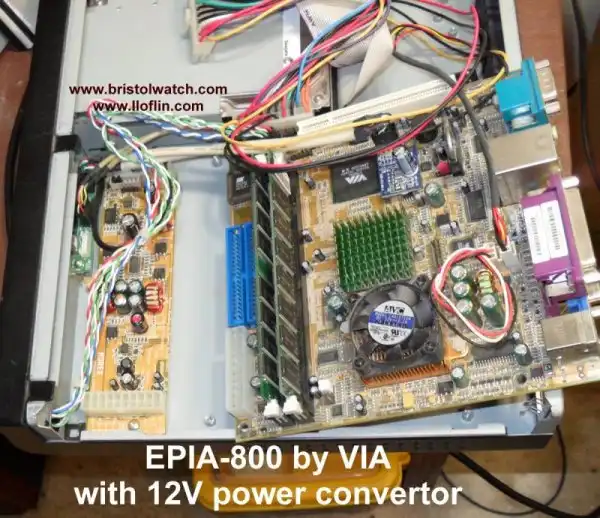
Fig. 2
Fig. 2 shows the switching power supply inside the computer case.
I happen to have another RAM module and operated mine at 512Meg. It did not come with a driver disk.
It did not come with the 12-volt 5-amp power or USB speakers. I supplied those that I happen to have. The motherboard could have been removed and installed in a standard ATX case and power supply.
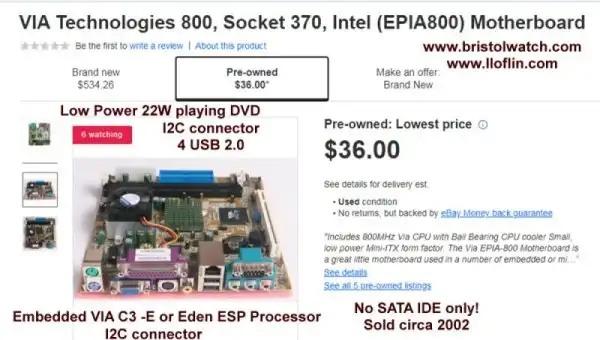
Fig. 3
Fig. 3 illustrates a typical Ebay ad. I added the specifications.
I use mine as an electronics controller running Tinycore Linux. It works OK on Windows Me and Windows 98. It mostly runs on Debian 7 but slow on the Seamonkey web browser.
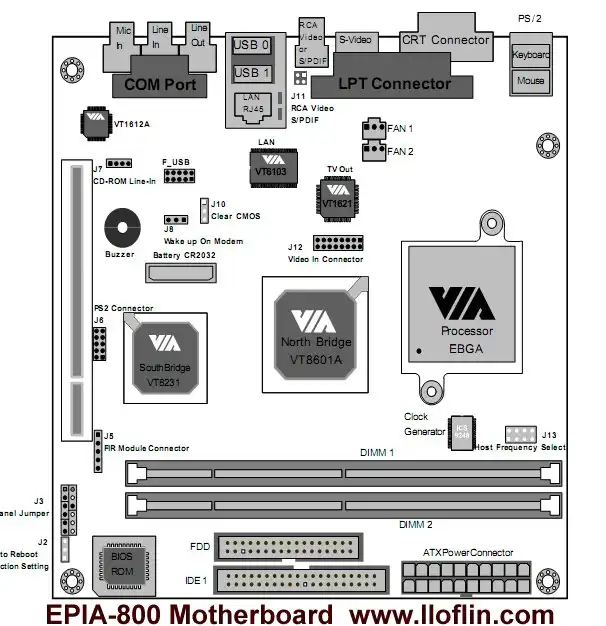
Fig. 4
The big plus side is low power consumption. As little at 20-watts for the XMMS audio player in my tests. Normal operation is under 30-watts so the 60-watt 12-volt supply I used didn't even get warm.
The bad side is slow processor speed and it had not made the transition to more modern motherboards. It had floppy disk and IDE connectors, but no SATA connectors. Thus no way to use a solid state drive.
The EPIA-800 motherboard top view is shown in Fig. 4.
The four USB ports (two on the back panel two more on a header) seemed to be USB1.1 or early USB2.0. They seemed slow but good enough for a keyboard and mouse.
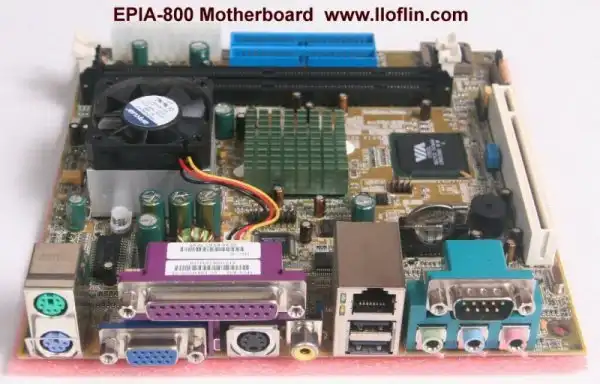
Fig. 5
The good part about the VIA EPIA-800 motherboard was lots of peripherals. This includes parallel port, serial port, VGA and several video-audio ports, PS-2, etc.
Specifications
Manufacturer VIA Technologies, Inc.
Form Factor mini ITX; Processor Socket 370; Compatible Processors C3, Eden ESP 5000, 800MHz installed.
CPU Embedded VIA C3 Processor Internal L1 128KB and L2 64KB cache memory. Chipset: VIA 8601A North Bridge, VT8231 South Bridge.
Graphics: Integrated Trident Blade 3D graphics core. Audio: VT1612A 2 channel AC97 Codec 3. Audio jacks: Line-in, Line-out and Mic-in.
Main Memory 2 x PC100/133 DIMM slots. PCI Bus IDE Ultra DMA 33/66/100. LAN VIA VT6103 10/100 Base-T Ethernet PHY.
2 USB ports, 1 onboard USB pin header for up to 2 additional connections. USB v1.1 and Intel Universal HCI v1.1 compatible.
- Hobby Electronics Home Page
- Donate
- Exploring Digital Computer Electronics
- Hardware
- Hardware Review Connecting PC Parallel Ports
- Operation TB6600 Stepper Controller with PC Parallel Port
- Build or Buy Parallel Port Breakout Board?
- Build Serial HD44780 LCD Display Connect to Parallel Port
- Motherboards
- Presario 1999 CM1001 Gaming Computer Salvage
- Live Test 2002 VIA EPIA-800 Mini ITX Motherboard
- Salvage, Test 2012 AAEON EMB-B75A Industrial Motherboard
Related programming and hardware:
- Main Light Fast Linux Desktops with Openbox, JWM
- Test Reuse Surplus PC Power Supplies
- Add WBAR Launch Dock to Raspberry Pi
- Add MPG123 Terminal Music Player to Raspberry Pi, Linux
- Basics of Alsamixer Audio Control for Linux
- Add Solid State Hard Drive to Raspberry Pi
- Beep a PC Speaker Add Beeper to Raspberry Pi
- Using FEH Wallpaper Setter Under Linux
- Scrot Lite Weight Screen Shot Software for Linux
- Using Light Weight Beaver Text Editor
- Install Viewnior Image Viewer for Linux
- Zmixer ALSA Sound Control Tutorial
- Tutorial Xinitrc Desktop Manager Control for Linux
- Setup Raspberry Pi Using JWM Window Manager
Linux Videos
Live Linux Distro for Using Printer Port with Electronics
Using the powerful Rox-Filer system in Linux
Use FEH under Linux for a Wallpaper Setter
How to create Symbolic links in Linux
- Off Site:
- Web Master
- Tri-Cities VA-TN
- General Science
- Hobby Electronics
- US Constitution
- Christianity 101
- Religious Themes
Web site Copyright Lewis Loflin, All rights reserved.
If using this material on another site, please provide a link back to my site.